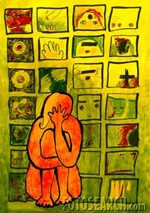When Violence Hits Close to Home
 Mark Olson, a Big Lake-area legislator recently reelected to his eighth term, was charged with fifth-degree domestic assault for hitting his wife (forcing her to the floor). Instead of using it as an opportunity to educate the public on the epidemic level of abuse in America (and Minnesota), the media has instead made it into just a problem for Olson his political party.
Mark Olson, a Big Lake-area legislator recently reelected to his eighth term, was charged with fifth-degree domestic assault for hitting his wife (forcing her to the floor). Instead of using it as an opportunity to educate the public on the epidemic level of abuse in America (and Minnesota), the media has instead made it into just a problem for Olson his political party.But it’s a lot more than just another story. Not when domestic violence accounts for over 25% of the crimes reported in Minnesota yet we know that 80% of all domestic abuse goes unreported. The story of Mark Olson is played out everyday over and over again in Minnesota’s homes.
Given Olson’s past aggression against a women and his refusal of treatment, his current punishment should be the maximum that can be given by both the court system and his legislative peers.
Orvell’s Grave has a good perspective on this issue and well worth the read especially for men!
Most men in this country are not violent, most do not beat their wives and girlfriends. Despite that fact, domestic violence is really a gender issue. Men commit 90 to 95 percent of domestic violence acts. I think most men instinctively know this is true, but most men find it really hard to talk about it, think about it, or much less do anything about it.
Some men believe that because he is not violent or it's not happening in his family, he needn't do anything. Some men believe it is a "woman's" issue, so he can really ignore it. Some men can't imagine talking about this issue with other men, some of whom he might suspect are abusing women in their lives.Let's face it. This is an embarrasing issue for men. It's much easier for us to simply let women try to take care of this problem. It's really hard for most men to admit that this is our problem.
Violence against women is men's violence. Can we find a way to help men own this problem and work together to solve it? How can we end the pervasive silence? How can we help our communities get past the attitude that this happens someplace else, certainly not where we live?Given the prevalence of male violence against women, why has this not been a very public men's issue. Isn't it really in men's self-interest to address gender violence? Don't most of us really care about the women and girls in our lives?
Ignoring violence, not responding to it, looking the other way, or worse yet treating it like an isolated act flies in the face of all we know about domestic violence. Here are some facts about domestic violence in Minnesota. After you read it, have a heart to heart with the women and girls in your life. They deserve respect and a safe place in our culture:
- Twenty-six women and four children were murdered in Minnesota in 2005 as the result of domestic violence or child abuse.
- In fiscal year 2005, 36,550 women and children were served by community advocacy programs for battered women.
- In fiscal year 2005, battered women in Minnesota spent 98,622 nights in safe shelter and children spent 105,448 nights in safe shelter.
- One of every three homeless women in Minnesota is homeless at least in part due to domestic violence.
- In 2004, 998 Minnesotans received emergency department or in-hospital care for domestic violence related injuries. 97% of the victims were women.
- 70 percent of domestic violence victims were victimized more than once in 2001. Domestic violence victims accounted for over a quarter of all violent crime victims in 2001.2002 Minnesota Crime Survey
- Over 80 percent of victims of domestic violence in Minnesota did not report the incidents to law enforcement.
- 12,376 Orders for Protection were filed in Minnesota in 2004.
- Domestic violence victims account for over 25 percent of all violent crime victims [in Minnesota].
- Domestic violence is a major public health problem that exceeds $5.8 billion each year in the United States in health-related costs.
- Over 1.7 million workdays [in the United States] are lost each year due to domestic violence. Employers lose between $3 billion and $5 billion every year in absenteeism, lower productivity, high turnover, and health and safety costs associated with battered workers.
- On average [in the United States], more than three women are murdered by their husbands or boyfriends in this country every day. In 1999, 1, 642 murders were attributed to intimates; 74 percent of the murder victims (1,218 total) were women.
- During the six months following an episode of domestic violence, 32% of battered women are victimized again.
- Nearly one-third of American women (31 percent) report being physically or sexually abused by a husband or boyfriend at some point in their lives.
- Fathers who batter mothers are two times as likely to seek sole custody of their children. 40 to 60 percent of men who abuse women also abuse children.
- Each year, an estimated 3.3 million children are exposed to violence by family members against their mothers or female caretakers.
- 90 - 95% of domestic violence victims are women.
- Approximately one in five female high school students reports being physically and/or sexually abused by a dating partner
- Women of all races are about equally vulnerable to violence by an intimate.



.jfif)
Comments